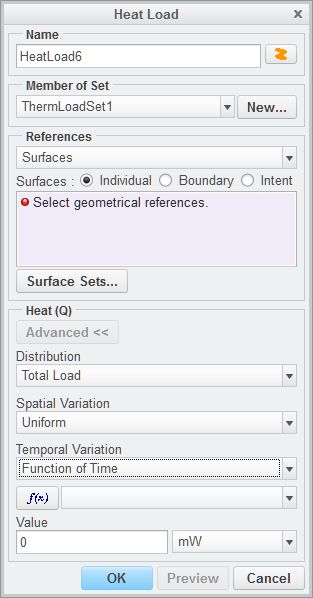Community Tip - When posting, your subject should be specific and summarize your question. Here are some additional tips on asking a great question. X
- Community
- Creo+ and Creo Parametric
- 3D Part & Assembly Design
- Re: Multiple convection coefficients?
- Subscribe to RSS Feed
- Mark Topic as New
- Mark Topic as Read
- Float this Topic for Current User
- Bookmark
- Subscribe
- Mute
- Printer Friendly Page
Multiple convection coefficients?
- Mark as New
- Bookmark
- Subscribe
- Mute
- Subscribe to RSS Feed
- Permalink
- Notify Moderator
Multiple convection coefficients?
Does anyone know if its possible to simulate a steel plate that is subjected to a high convection coefficient and high bulk temp for the, say, first 4 - 5 seconds, and then subsequently be subjected to a low convection coefficient and low bulk temp for the remaining 2-3 minutes?
I want to simulate a steel plate that is subjected to a welding torch on one side of the plate for 4-5 seconds and then move the welding torch away from the plate.
Is this just a matter of combining constraint sets? Thanks,
Paul
This thread is inactive and closed by the PTC Community Management Team. If you would like to provide a reply and re-open this thread, please notify the moderator and reference the thread. You may also use "Start a topic" button to ask a new question. Please be sure to include what version of the PTC product you are using so another community member knowledgeable about your version may be able to assist.
- Labels:
-
Weld Design
- Mark as New
- Bookmark
- Subscribe
- Mute
- Subscribe to RSS Feed
- Permalink
- Notify Moderator
Hi Paul
In a transient thermal you can add a time function to a convection condition, look at the attached picture.
If you need more info, do not hesitate to ask!
Regards
Erik
- Mark as New
- Bookmark
- Subscribe
- Mute
- Subscribe to RSS Feed
- Permalink
- Notify Moderator
Hi Erik,
I can see from the image that it's possible to apply a temporal variation on the bulk temperature by defining an equation or table, but I'm more interested in having the convection coefficient change value as a function of time.
For example, can the convection coeff in your model (.1 mW/(mm^2 C) change to another value over time? Or is there something in the pull down menu from the pic you've attached that shows this and I'm somehow missing it? thanks!
- Mark as New
- Bookmark
- Subscribe
- Mute
- Subscribe to RSS Feed
- Permalink
- Notify Moderator
Hi Paul
You're right it looks like it's only the bulk temperature. Maybe you can work with that in a similar fashion as heat transfer is proportional to convection condition times temp difference. If you make the temperature difference small, there is little or no convection.
Or differently, I would model your welding torch as a heat load, which can vary over time using a function or a table.

Erik

